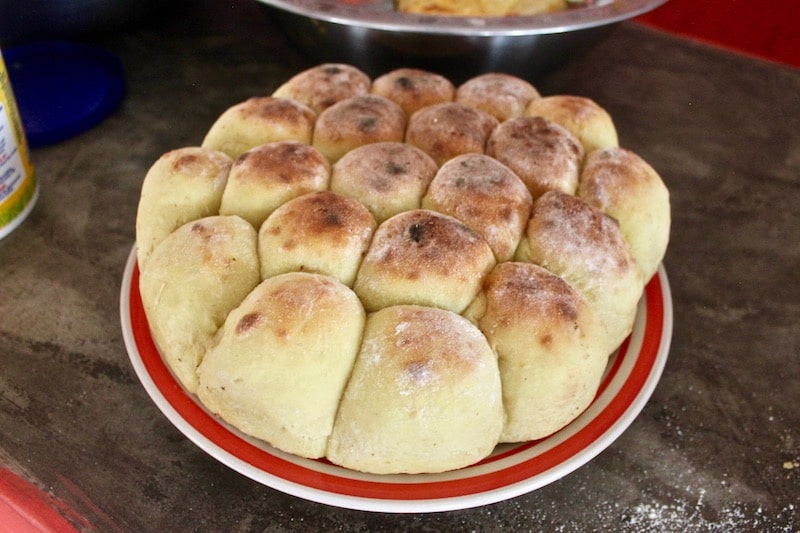By Brianne Miers, Epicure & Culture Contributor
In many places in the world, cooking is still considered “women’s work.”
However, Malawi’s Emmanuel Nkhata hasn’t let that stop him from pursuing an exciting culinary career.
It was his father, Morgan, who inspired him to take this still-unconventional path. The senior Nkhata has worked as the head chef of Japan Tobacco International in the capital city of Lilongwe for the past 11 years.
When Emmanuel finished high school, he knew he wanted to see more of the country – and world.
His curiosity about other cultures and cuisines led him to consider a career in journalism, but he ultimately decided to pursue a degree in tourism and hospitality management.
He was one of only five men in the program.

From Intern To Professional Malawian Chef
During an internship at Lifupa Conservation Lodge in Kasungu National Park, he met staff of Lilongwe Wildlife Trust (LWT).
LWT has been operating a research base with Conservation Research Africa further north at Vwaza Marsh Game Reserve since January 2017, and it was LWT staff who later recommended Emmanuel to a nonprofit organization planning to host “citizen science” volunteers at the Vwaza camp.
“They were impressed to see a young person doing great things in the kitchen,” he says of LWT.
Have you tried the food of #Malawi? Learn how one chef is redefining #MalawianCuisine
A Malawi Cuisine Challenge
Although he was excited about the possibility of having so much responsibility, he admits he was a little skeptical at first, since the expeditions were committed to serving only vegetarian meals to volunteers.
Even though Malawians don’t eat a lot of meat – chicken is eaten occasionally and communities who live close to Lake Malawi enjoy fish – Emmanuel knew it would be a challenge to put together an exclusively vegetarian menu, especially one that was appealing to groups of tourists from different countries all over the world. However, he decided, “This is my shot.”
I got to meet Emmanuel when I participated in one of the Vwaza volunteer expeditions in October 2019.
As a vegetarian for more than 20 years, I can attest that he more than rose to the occasion, especially considering he was working in a remote area with limited ingredients, and cooking for about 20 people in a kitchen that’s not much bigger than the size of a walk-in closet.
Even the meat-eaters in our group would rave about the meals.

A Delicious Malawi Menu
For breakfast most days, he made us omelets with green peppers, served along with thick toast and slices of avocado — which we were all surprised to find, and they were even a little creamier than the ones I’m used to eating in the USA.
The base for lunch and dinner was typically rice or pasta, served with a tomato-based stew that included beans and vegetables like cauliflower.
The side was usually a tomato, cucumber and onion salad, sometimes mixed with cabbage and dressed with a little olive oil.
Corn was often incorporated into the meal somewhere, as it’s a staple of the Malawian diet. I saw grilled corn being sold all over at roadside stands.
There was always sliced fruit for dessert – mostly watermelon and pineapple.
How delicious is this menu in #Malawi? Learn more about how one local chef is redefining #MalawianCuisine!
Emmanuel says that pumpkin curry has become his favorite meal to cook for the groups that come through Vwaza — the largest so far was a 40-person university group from the United Kingdom.
While he prefers eating typical Malawian foods like nsima with sautéed cabbage and beans – that was one of my favorite meals he made for us – he has grown to like some of the Western dishes he’s created like spaghetti with a soy Bolognese sauce and pasta salad with hard-boiled eggs.
Connections Through Malawian Food
What was the best thing about working at Vwaza?
“Meeting the people,” he says.
Now that the expeditions are finished for 2019, Emmanuel is back home in Lilongwe, where he runs a catering business making pastries for weddings and events.
In his spare time, he enjoys cooking for his friends and family and insists that his mother take at least one day off from the kitchen each week to relax.

“I do this for my family,” he says. “They’re the first people I have to impress.”
Looking Toward The Future
Emmanuel is certain to impress others as well, as he continues to build his reputation and resume. He says he wants to gain experience by working at other tourist destinations in Malawi or even elsewhere on the continent.
“You can go anywhere,” he says of the myriad opportunities available for chefs in hotels and lodges throughout Africa.
Ultimately, though, he wants to return to Lilongwe and open up a take-away restaurant serving Malawian specialties, perhaps with an international flair.
Have you tried #MalawianCuisine? Here is a #NsimaRecipe so you can bring the food of #Malawi to your kitchen!
Traditional Malawian Food: Nsima Recipe
Nsima is a popular dish throughout Malawi and Zambia (where it’s known as nhsima).
It’s a soft and sticky corn-based patty that you eat by tearing into pieces and dipping into soup, sauces or stew.
This recipe was originally published on the blog International Cuisine. Darlene, the blog’s creator, is cooking a meal from every country in the world. It is being shared with permission from Darlene.
Ingredients
- 3 cups water
- 1 cup cold water
- 2½ cups cornmeal
Instructions
- Boil the 3 cups of water in a saucepan.
- In a bowl, make a paste using part of the cornmeal and all the cold water.
- Add the paste to the boiling water
- Stir with a spoon until the mixture has a thick porridge-like texture.
- Cover the saucepan and simmer for 15 minutes
- Turn heat to the lowest setting, remove the lid and gradually add the rest of the cornmeal, stirring constantly.
- Continue until the mixture thickens to the desired consistency.
- Cover and cook on lowest heat for another 5 minutes.
- Stir before serving and shape as desired.
Have you tried Malawian cuisine, either traditional food like nsima or dishes with a modern flair?
Brianne Miers
Latest posts by Brianne Miers (see all)
- Malawi Cuisine: The Chef Redefining Traditional Food (+Nsima Recipe) - Dec 10, 2019
- How To Volunteer In Guatemala & Help Local Youth - Apr 5, 2018






Wow! What a story of transformation and taking on a challenge! Love the story and photos!
Thanks for reading, Sherry! Emmanuel definitely has a bright future ahead.
Love the story. Nsmia should read Nsima – the i and m are in the wrong place.
Thanks for reading, and thanks for catching the typo!
Thanks alot Brianne for the article, and to you guys who love it
Thank YOU, Emmanuel!
Hello Emmanuel! I am interested in you culinary talents and have a job proposition for you. How can I reach you? Please send me your email address at [email protected].
What I would like to say about your post is that you only need to have a look, at first glance, you understand how hard people have worked to write your post, you have not put any useless content at all. . Wrote my post in beautiful words.
Excellent write-up, I was able to enjoy a really interesting read
good post
good post Nice info
Wow! What a story of transformation and taking on a challenge! Love the story and photos! sir
love you foto
Thanks alot Brianne for the article sir
Thanks new information